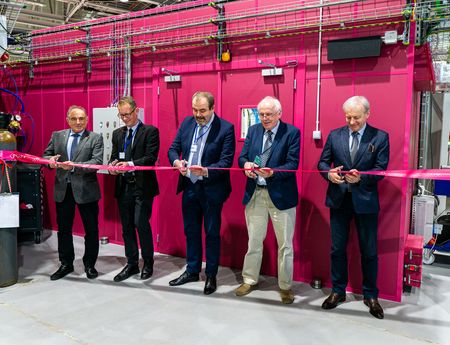
On 1 March 2024, the official opening ceremony was held in the SOLARIS National Synchrotron Radiation Centre for the POLYX beamline, used in X-ray microimaging and X-ray microspectroscopy in the energy range 4-15 keV. The beamline enables imaging of 2D and 3D structure, elemental distribution, and chemical phases of the investigated samples. The facility was built jointly by the Jagiellonian University, the AGH University of Science and Technology and the Institute of Nuclear Physics of the Polish Academy of Sciences.
The event began with a welcome address to the guests by Prof. Marek Stankiewicz, Cooperation Representative of the SOLARIS National Synchrotron Radiation Centre. He thanked the entire SOLARIS team for their involvement in the construction of the POLYX beamline, especially Prof. Paweł Korecki, Dr Katarzyna Sowa, Dr Tomasz Kołodziej and Dr Paweł Wróbel.
Next, Prof. Paweł Korecki briefly presented the history of the beamline, talking about its technical specifications and uses as well as about the first successful projects carried out by the research team. The POLYX beamline is unique in that it is the first X-ray beam that comes out of a vacuum from the SOLARIS ring, meaning that it can be used to conduct research in the air.
The organisers stressed the crucial role of POLYX researchers in the endeavour, stating that their determination and productive cooperation between specialists resulted in a unique and compact beamline that can be sued for imaging of 2D and 3D structure of objects, elemental distribution mapping and information about speciation and local atomic structure.
The name POLYX derives from polycapillary X-ray optics as well as polychromatic X-rays that will be used in the beamline. It will allow for conducting research in biomedical sciences, materials science, physics, chemistry, Earth sciences & environmental sciences, and cultural heritage sciences.
Attendees of the event had the opportunity to visit the experimental hall of the SOLARIS Centre and learn more about the research carried out at the synchrotron. This was followed by a ribbon-cutting ceremony and commemorative photos. The opening date was no coincidence: it was on 1 March that the spring call for proposals started, for the first time offering the possibility of applying for research time on the POLYX infrastructure.
Source: SOLARIS synchrotron





